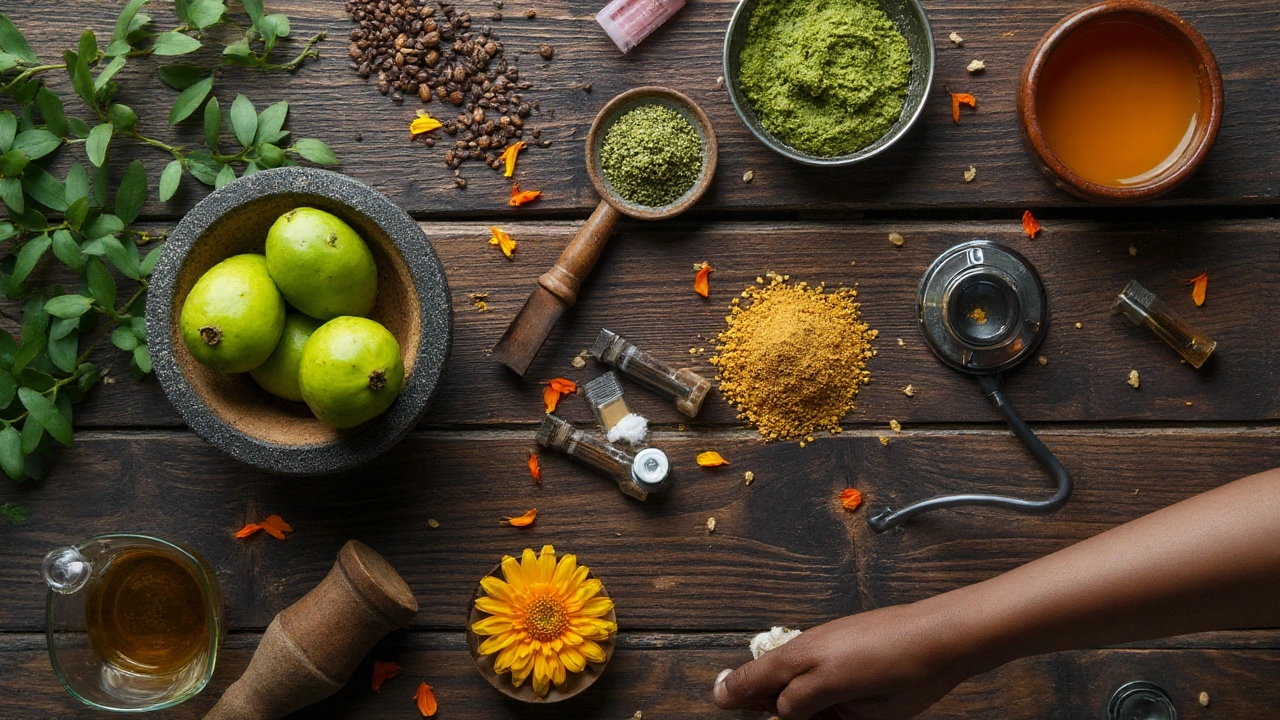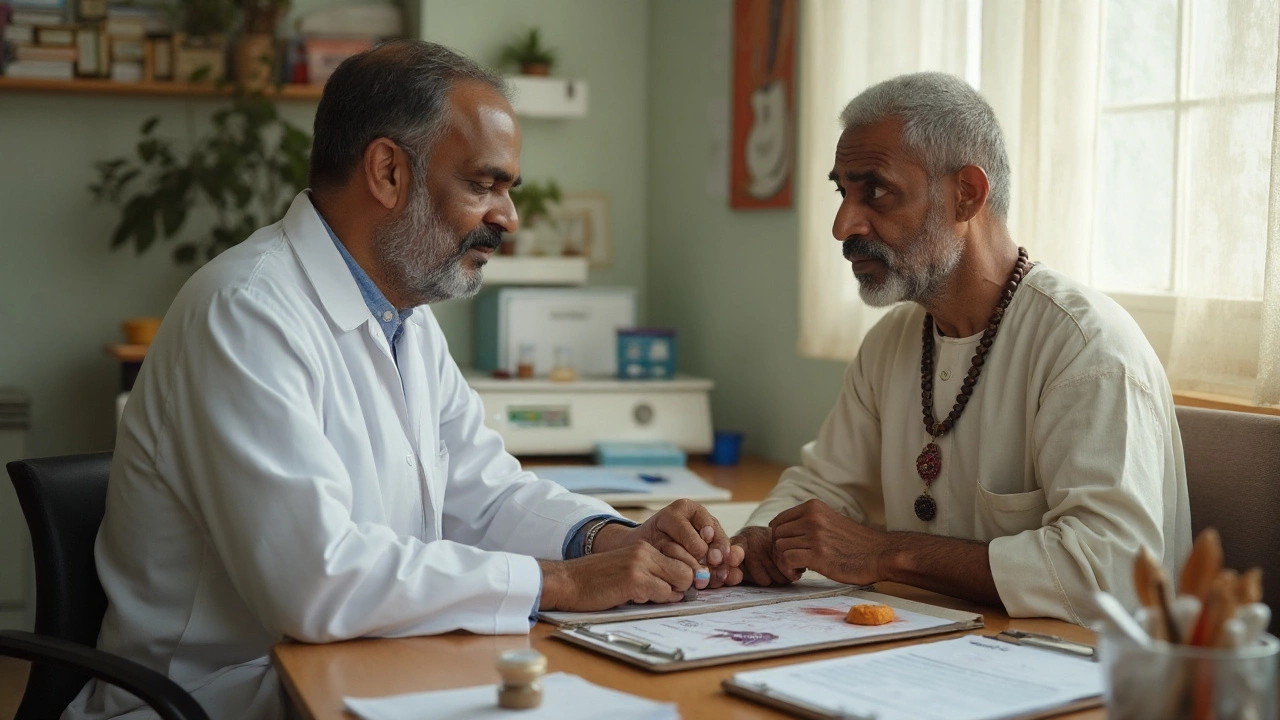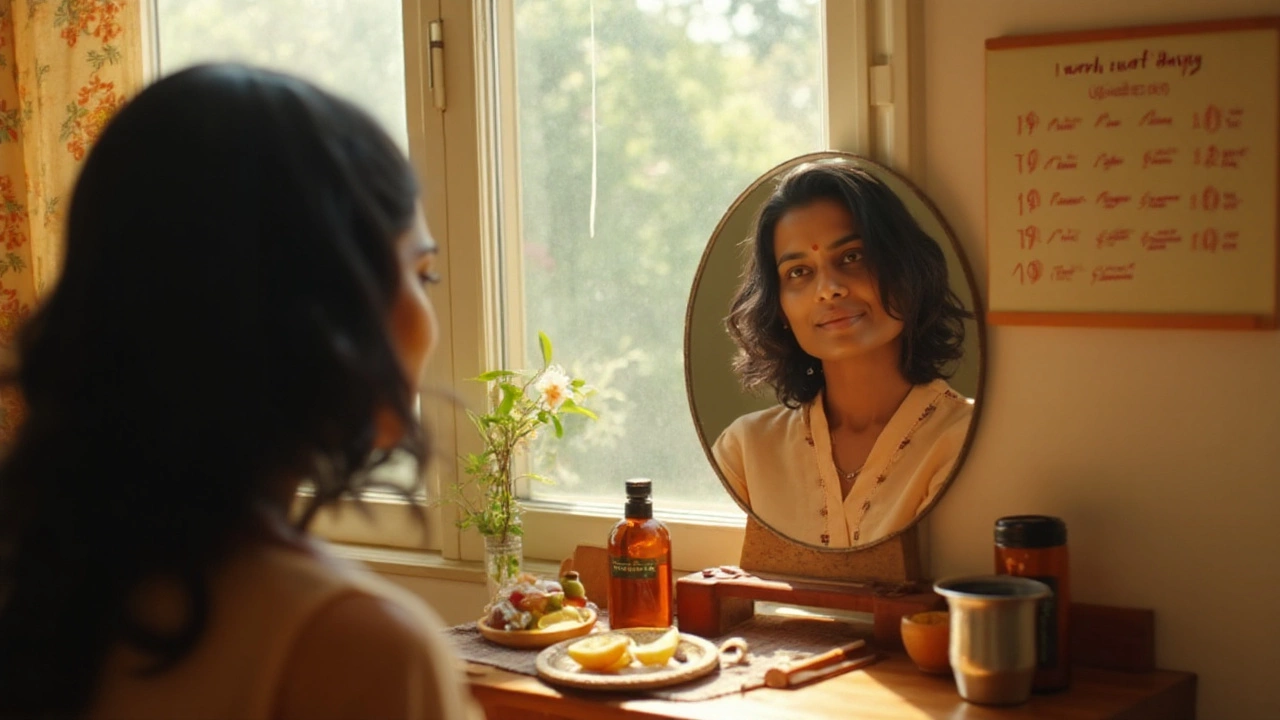- TL;DR: True reversal of grey hair is rare. Ayurveda can slow, sometimes partially repigment, and often prevent further greying if you fix the root cause early.
- First check for fixable triggers: B12 and vitamin D deficiency, thyroid issues, stress, smoking, and harsh hair routines. Correcting these can restore pigment in some people.
- Ayurvedic playbook: daily oiling (bhringraj/amla), rasayana (amla, sesame, black sesame), gut and sleep repair, and stress relief practices. Give it 3-6 months.
- Evidence: modest human data, stronger traditional use and animal/lab studies. Safe when done right; avoid mega-dosing herbs and untested powders.
- Use a plan: labs, 12-week routine, quality products, and review at week 12. Expect maintenance, not miracles.
Here’s the straight answer you came for: can you reverse grey hair in Ayurveda? Sometimes, yes-if the greying is early and due to a reversible trigger (deficiency, thyroid, stress, smoking). If the follicle’s pigment cells are gone, no system can reliably bring them back. Ayurveda won’t promise magic, but it gives you a structured way to slow, protect, and, in select cases, roll back a bit.
What Ayurveda can-and can’t-do for grey hair
Grey hair happens when melanocytes in your hair follicle stop making pigment (melanin). This can be age-related or triggered early by stress on the follicle (oxidative stress, nutrient deficits, thyroid imbalance, smoking). Modern research shows hydrogen peroxide builds up in hair follicles with age while catalase-an enzyme that breaks it down-drops. This oxidative hit can bleach hair from the inside. A 2009 paper in The FASEB Journal described this mechanism in detail, tying it to greying physiology.
Ayurveda describes premature greying (palitya) as a disturbance of pitta, agni (metabolism), and ojas (vitality), often fed by stress, poor sleep, low-nutrient diet, and harsh grooming. The goal: reduce pitta/oxidative load, nourish tissue (rasa-rakta), and support hair (keshya) with oils, herbs, and daily rhythms.
What this means in real life:
- Possible: slowing further greying, improving hair quality, and partial repigmentation in some strands-especially if caught early (teens to 30s) and a trigger is corrected.
- Unlikely: turning fully white hair uniformly black again after years. Case reports exist of repigmentation when B12 or thyroid issues are fixed, but they’re not the norm.
- Honest timeline: the hair you already see is “dead fiber.” You’re influencing the NEW growth from the follicle. Expect 3-6 months to see if short baby hairs grow darker.
What the evidence says (plain English):
- Deficiency correction can help: Dermatology and trichology journals have reported repigmentation when B12 deficiency or hypothyroidism is treated in young adults.
- Oxidative stress is central: lab studies point to hydrogen peroxide and low catalase inside follicles; antioxidant strategies make sense.
- Ayurvedic herbs: animal and cell studies suggest bhringraj (Eclipta alba), amla (Emblica officinalis), and neeli (Indigofera tinctoria) support melanogenesis and reduce oxidative stress. Small human trials focus more on hair growth and quality than pure greying reversal.
I live in Bangalore, where hard water, long commutes, and late-night work are common. I see two patterns: 1) early greying in students and tech workers with brutal sleep and high caffeine; 2) patchy greying in smokers with fast food and no sunlight. Ayurveda targets both patterns by fixing the basics and adding targeted care.

Your practical Ayurvedic plan: tests, routines, herbs, diet, and lifestyle
Most readers land here with a few jobs to be done. You likely want: a clear yes/no on reversal, a plan you can follow, safe herbs/oils that actually help, and how to measure progress. Use this section like a mini playbook.
Step 1: rule out fixable causes (2 weeks)
- Get these labs if you’re in India: CBC, Vitamin B12, 25(OH) Vitamin D, TSH (thyroid), ferritin, fasting glucose, HbA1c. If you’re vegan/vegetarian or have gut issues, B12 is key.
- History check: sudden greying after severe stress? Recent crash diets? New medications? Smoking or vaping? Bleach/dye history?
- If you’re under 30 with rapid greying, prioritize B12, ferritin, thyroid-and book a GP or dermatologist consult for guidance.
| Root cause | What to test or change | Why it matters | Repigmentation odds |
|---|---|---|---|
| Vitamin B12 deficiency | B12, CBC | Melanin synthesis needs B vitamins; deficiency linked with premature canities. | Moderate if caught early |
| Vitamin D insufficiency | 25(OH)D level | Low D correlates with hair issues; correcting supports follicle health. | Low-moderate via support |
| Iron deficiency | Ferritin | Low iron impairs hair structure and growth. | Low-moderate via support |
| Thyroid dysfunction | TSH, FT4 if needed | Hypo/hyperthyroid alters hair cycles and pigment. | Moderate in young patients |
| Stress/poor sleep | Sleep diary, HRV/subjective stress | Stress hormones and oxidative load impact melanocytes. | Supportive; helps slowing |
| Smoking | Quit plan | Strongly associated with early greying in Indian cohorts. | Helps prevent progression |
Step 2: a 12-week Ayurvedic routine (build pigments, reduce oxidative stress)
- Daily/alternate-day oiling (Shiro abhyanga): use Neelibhringadi taila or a clean bhringraj-amla oil. Massage into scalp for 5-10 minutes, leave 45-60 minutes or overnight if suits your scalp, then wash with a mild, sulfate-free shampoo.
- Weekly deep treatment: warm oil pack once a week. Wrap a warm towel for 10 minutes after application to aid penetration.
- Rasayana support: amla powder 3-5 g daily with warm water or churnam; or 1-2 amla fruits daily. Black sesame seeds 1 tablespoon daily after breakfast if you tolerate seeds. Consider chyawanprash 1-2 teaspoons in the morning during cooler months.
- Diet for pigment: add one iron-rich and one vitamin C source daily (e.g., palak + amla/lemon). Include good fats (ghee, sesame oil) for nutrient absorption. Protein 0.8-1 g/kg bodyweight, especially if you’re vegetarian.
- Stress and sleep hygiene: 10-15 minutes of Nadi Shodhana or box breathing in the evening, plus a 20-30 minute walk in morning sunlight. Aim for 7-8 hours sleep; phone off 60 minutes before bed.
- Gentle hair care: limit heat styling, avoid frequent bleaching, switch to a filter or bucket rinse if your tap water is very hard (common in Bangalore apartments). Use lukewarm, not hot, water.
Step 3: targeted add-ons (case-by-case, weeks 4-12)
- Nasya (medicated nasal drops): 2 drops of Anu taila in each nostril after oil massage and a warm shower, 3-4 times a week, can help pitta balance and sinus health. Learn technique from a practitioner first if possible.
- Seasonal cleanse: a light, food-based “reset” like 2-3 days of kitchari with warm water and early dinners helps if you feel heavy/acidic. Skip harsh detox kits.
- Copper-rich foods: sesame, sunflower seeds, nuts, legumes, and cacao. Do not supplement copper pills without medical advice.
Step 4: track, review, and adjust (week 12)
- Photos every 4 weeks in the same light-look for short, new growth near the hairline and parting. That’s where improvement shows first.
- If labs were low, recheck them now. If all is stable but greying gallops on, speak with a dermatologist for other options.
- Keep what works: most people maintain oiling 2-3 times weekly, amla and black sesame 4-5 days/week, and a breathing practice daily.
What to actually buy (India-friendly, budget-aware)
- Hair oil: Neelibhringadi taila, Bhringraj oil, or a clean amla-bhringraj blend from a trusted brand. Expect ₹200-₹600 for 100-200 ml.
- Amla: whole fruit (₹20-₹40 each in season) or food-grade powder (₹200-₹400/250 g). Choose brands that test for heavy metals.
- Chyawanprash: stick to classical recipes; avoid products with added colors/flavors. Around ₹350-₹800/500 g.
- Shampoo: mild, sulfate-free, pH-balanced. You’re protecting your scalp barrier, not stripping it.
Recipes and routines you’ll actually follow
- 5-minute scalp oiling: warm 1-2 teaspoons of oil. Part your hair into 4 sections. Dab along parts. Use fingertips in slow circles, then long strokes. Finish with gentle ear-to-ear sweeps. Set a timer so you don’t rush.
- Morning amla tonic: 1 teaspoon amla powder + warm water + squeeze of lemon. If you get acidity, take after breakfast or add a pinch of jaggery.
- Evening wind-down: 5 minutes of Nadi Shodhana, 5 minutes of forward bends/child’s pose, warm shower, dim lights, no screens.
What success looks like at 12 weeks
- Slower spread of greys compared to the last quarter.
- Baby hairs near the temples with a darker root in some strands.
- Softer hair, less breakage, calmer scalp.
If you see none of the above, check adherence, retest labs, stop any harsh hair practices, and consider a doctor’s opinion. Not every follicle can be coaxed back.
| Ayurvedic ingredient | Proposed action | Evidence snapshot | Typical form/dose | Safety notes |
|---|---|---|---|---|
| Bhringraj (Eclipta alba) | Melanocyte support; antioxidant | Animal/cell studies suggest pigment support; traditional use is strong; limited human data | Oil for scalp; internal powders are practitioner-guided | Topical well-tolerated; internal use under guidance |
| Amla (Emblica officinalis) | Rasayana; vitamin C; antioxidant | Human data for hair quality; indirect role in pigment via antioxidant pathways | 1-3 tsp powder/day or 1-2 fresh fruits | May aggravate acidity; take with food |
| Neeli (Indigofera tinctoria) | Cooling; used in classical oils | Traditional; limited direct human evidence | Part of taila formulations | Use authentic formulations to avoid adulterants |
| Black sesame (Til) | Mineral-rich; supports hair in classics | Cultural and nutrient logic; no RCTs for greying | 1 tbsp/day with breakfast | Allergy possible; chew well; avoid if you have kidney stones risk without advice |
| Chyawanprash | Polyherbal rasayana; antioxidant | Small human studies show antioxidant benefits | 1-2 tsp morning | Check sugar if diabetic; pick reputable brands |
Why labs and lifestyle matter more than any one herb
Greying is a systems story. Correcting B12 or thyroid issues has documented cases of hair repigmentation in dermatology literature, especially in younger people. Quitting smoking reduces oxidative burden. Fixing sleep calms cortisol and catecholamines that stress follicles. In other words, herbs sit on a foundation. Without the foundation, even the best oil is just a nice fragrance.

Evidence, timelines, safety, and smart alternatives
What the science and classics agree on
- Oxidative stress is the villain. Modern studies point to hydrogen peroxide build-up and low catalase in aging follicles; Ayurveda frames it as pitta/agni imbalance. Different words, same direction: reduce oxidative load.
- Prevention beats reversal. Starting early-teens and 20s-gives the best odds of slowing greying. Waiting until hair is uniformly white reduces your chances.
- Holistic beats single fixes. Amla without sleep, or oiling without protein, won’t move the needle much.
What’s realistic in 2025
- Timeframe: 12 weeks to see if you’re a “responder,” 6-12 months for your personal ceiling of benefit. Maintenance is ongoing.
- Partial repigmentation: possible in streaks and strands. It often shows as darker roots on new growth, not a sudden color change in old hair.
- Stopping progression: very achievable with habits locked in, especially if you ditch smoking and repair sleep.
Safety rules that keep you out of trouble
- Avoid heavy-metal contamination: pick brands that publish quality tests (lead, arsenic, mercury) for powders and bhasmas. Skip mystery “kali pili” capsules from social media.
- Don’t mega-dose herbs: more is not better. Stick to food-like doses unless a practitioner guides you.
- Patch test oils: apply a drop behind your ear for 24 hours if you have sensitive skin or eczema.
- Mind medications: if you’re on thyroid meds, anticoagulants, or metformin, discuss new supplements with your doctor.
What about salon dyes and modern actives?
- Dyes: safe if used properly, but they don’t fix the cause. If you dye, space sessions 6-8 weeks, use mild developers, and oil the scalp between sessions.
- Catalase shampoos: marketed for greying, but evidence is thin. Safe to try, just don’t expect miracles.
- Peptides/actives: a few cosmetic peptides aim to support pigment. Early-stage data only. If you use them, keep your Ayurvedic base routine.
Heuristics and rules of thumb
- If you’re under 25 with sudden greys: test B12, vitamin D, TSH first before chasing fancy serums.
- If your parents went grey early: prevention habits matter most; lower your expectations for full reversal.
- If you’re bald or thinning plus greying: tackle scalp health and growth first-consistent oiling, protein, iron/ferritin if low-then judge color changes.
Cost and effort reality check (India, 2025)
- Monthly spend: ₹500-₹1,200 for oil + amla + mild shampoo. Add labs (₹2,000-₹4,000 one-time) if needed.
- Time: 10 minutes daily for oiling/breathing, 30-45 minutes weekly for a deeper session.
Mini-FAQ
- Can Ayurveda turn all my white hair black again? No. It can slow and sometimes partially reverse early greying. Fully white, long-standing hair rarely repigments.
- How long before I see changes? Check at 12 weeks for baby hairs and darker roots. Big shifts, if they happen, take 6-12 months.
- Is amla enough? Amla helps, but results come from the combo: oiling + rasayana + diet + sleep + stress care + fixing deficiencies.
- Will stopping oiling make it worse? Not worse, but you’ll lose the benefits (softer hair, calmer scalp, possible pigment support).
- Are henna or indigo safe? Pure henna/indigo are plant dyes and safer than harsh bleaches. Test for allergies and pick reputable sources.
Checklist: your 12-week action plan
- Week 0-1: get labs (B12, D, TSH, ferritin, glucose/HbA1c). Take baseline photos.
- Week 1-12: oil scalp 4-6 days/week, amla daily, black sesame 4-5 days/week, walk in morning sun, 7-8 hours sleep, breath work daily.
- Hair care: mild shampoo, no harsh heat, avoid bleaching, manage hard water.
- Lifestyle: quit smoking/vaping, protein at each meal, iron + vitamin C pairings.
- Week 12: recheck symptoms, labs if low earlier, repeat photos, decide what to keep or tweak.
What the research community is exploring
- Oxidative scavengers: boosting scalp antioxidants to counter hydrogen peroxide.
- Melanocyte niche support: keeping pigment stem cells alive longer.
- Microbiome and inflammation: how scalp ecology affects follicle stress.
Key sources to know (no links, just names you can search):
- The FASEB Journal (2009): hydrogen peroxide and catalase in hair greying.
- International Journal of Trichology: reviews on premature canities and nutrient links in Indian populations.
- Journal of Ethnopharmacology and Pharmaceutical Biology: preclinical work on Eclipta alba (bhringraj) and melanogenesis.
- Classical texts: Charaka Samhita, Sushruta Samhita (palitya, rasayana, shiro abhyanga, nasya).
Next steps and troubleshooting
- Teen or early 20s with rapid greying: run labs, build the routine now. Your window for partial reversal is the best.
- 30s-40s with steady greying: aim for slowing and hair quality. You might get some darker new strands; maintenance is your friend.
- Post-45 with established greys: focus on scalp health, shine, and gentle plant dyes if you want coverage. Keep the Ayurvedic routine for overall hair vitality.
- Persistent scalp irritation: switch oils (simpler formulas), reduce frequency, and see a dermatologist to rule out seborrheic dermatitis or psoriasis.
- No change at 12 weeks despite perfect adherence: revisit labs, remove any harsh salon treatments, consider a dermatologist consult for other causes.
If you’re expecting a silver-bullet herb, you won’t find one here. If you want a steady plan that respects both Ayurveda and modern biology, this is it: fix what’s fixable, feed your follicles, calm your system, and give it a fair run. Some will see strands turn darker at the roots. Many will see greying slow down. Almost everyone will get better hair quality and a calmer scalp. That’s a win worth the effort.
